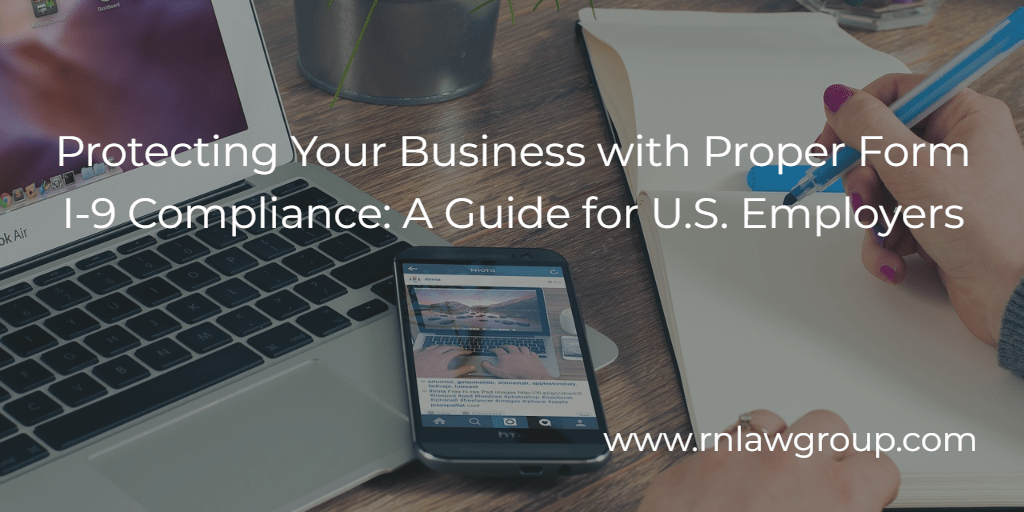
Protecting Your Business with Proper Form I-9 Compliance: A Guide for U.S. Employers
Employers in the United States have an important duty to ensure that their employees are authorized to work in the country. The U.S. Citizenship and Immigration Services, also known as USCIS, created Form I-9 as an essential tool for U.S. employers to verify and ensure that their employees are legally authorized to work in the United States. Federal law requires employers to complete Form I-9 for each new employee hired. Form I-9 is important for not only the employer, but the employee as well, as the form protects both parties from legal and financial consequences that may arise from the employment of unauthorized workers.
WHAT IS FORM I-9?
The Immigration Reform and Control Act (IRCA) requires all employers in the U.S. to verify the employment eligibility of their employees. Form I-9 is a two-page document used to verify the identity and employment eligibility of all employees hired by a company. There are three distinct sections which must all be completed correctly:
SECTION 1: Employee Information and Attestation
The first section is completed by the employee. Here, the employee must provide personal information such as their full name, address, date of birth, and social security number. The employee must then attest to their eligibility to work in the U.S. by selecting one of the following options:
- I am a citizen of the United States
- I am a noncitizen national of the United States
- I am a lawful permanent resident of the United States
- I am an alien authorized to work in the United States until (date)
If applicable, the employee must also provide their Alien Number/USCIS Number, Form I-94 admission number, or foreign passport number (including country of issuance), and the date their employment authorization expires. The employee must sign and date this section.
SECTION 2: Employer Review and Verification
The second section is completed by the employer and must be completed and signed within three (3) business days of the date of hire of the employee. Date of hire means the first day of work for pay.
Here, the employer will review the employee’s identification documents and verify that these documents are genuine and relate to the employee who presents the documents. The employer will record the type of documents provided, the document numbers, and the expiration dates. The employer must also sign and date this section. A list of the acceptable documents and combinations of documents can be found here: Form I-9 Acceptable Documents
SECTION 3: Reverification and Rehires
The third section is completed by the employer if the employee’s employment authorization requires reverification or if the employee is rehired within 3 years of the date that Form I-9 was originally completed. This section may also be completed if the employee has a legal name change.
COMMON ERRORS IN COMPLETING FORM I-9
Verifying that employees are authorized to work in the U.S. not only protects employers from liability for employing unauthorized workers, but also protects the U.S. workforce by ensuring that job opportunities are reserved for those who are legally authorized to work in the U.S. It is very important for employers to complete Form I-9 correctly. Failure to comply with the IRCA requirements can result in significant penalties, fines, and legal action against the employer.
There are several common mistakes that employers make when completing Form I-9. As stated above, these mistakes can lead to penalties and fines for the employer, and can also put the employer at risk of hiring unauthorized workers and facing legal action. Some of the more common mistakes include:
- Failure to complete the form in a timely manner: As previously stated, employers must complete and sign Form I-9 within three (3) business days of the employee’s first date of work.
- Incorrect or incomplete information: Employers must ensure that all information provided by the employee is accurate and up-to-date.
- Accepting incorrect documentation: Employers must ensure that employees provide the correct and sufficient documentation to prove not only their identity but also their work authorization. The employer must also make sure that the documentation presented is unexpired and belongs to the employee in question.
- Failure to reverify work authorization: Employers must ensure that employees with temporary work authorization are reverified before the authorization expires.
- Failure to retain the form: Employers must keep Form I-9 on file for each employee for at least three years after the date of hire OR one year after the employee’s termination, whichever is later. The forms must be made available for inspection upon request of authorized government officials.
- Using an outdated form: USCIS periodically updates Form I-9 and employers must use the most current version.
CONSEQUENCES TO IMPROPER FORM I-9 COMPLETION
The major consequence to an improperly completed Form I-9 is facing penalties and fines. The amount of the penalty the employer will face due to failure to comply with the regulations depends on the severity of the violation. If there is a pattern or practice of repeated violations, employers may even face criminal charges which could result in imprisonment. Employers may also face debarment from government contracts, and if there is a finding of discrimination against an individual, the employer may be ordered to provide back pay to or ordered to hire the individual. One of the unforeseen consequences to violating Form I-9 regulations is damage to a company’s reputation. Being known as an intentional violator can result in the loss of business opportunities as violating employers can be seen as irresponsible or untrustworthy which can negatively affect their relationships with customers, suppliers, or other business partners.
BEST PRACTICES FOR COMPLETING FORM I-9
There are several best practices that employers should follow when completing Form I-9:
- Make sure to understand the requirements for Form I-9, including the deadlines for completion and the different types of documents deemed acceptable for verifying identity and work authorization.
- Train HR staff and hiring managers on how to properly complete Form I-9 including how to identify the acceptable documentation and how to avoid discrimination and non-compliance.
- Many employers now use an electronic I-9 system to simplify and streamline the process to ensure accuracy and completeness.
- A written I-9 policy should be developed to outline the procedures and determine who is responsible for completing the form. How errors and discrepancies will be addressed should also be determined.
- Regular audits should be conducted to ensure Form I-9s are complete, accurate, and up-to-date. Audits also help identify any errors or issues that should be addressed.
In conclusion, complying with the regulations set forth by the Immigration Reform and Control Act is crucial for all U.S. employers. Form I-9 is an essential tool used for verifying the identity and employment eligibility of all employees and properly completing the form protects not only the employer, but the employee as well, from legal and financial consequences that may arise from unauthorized employment. However, improper completion of the form can lead to significant penalties and fines to the employer, therefore, it is extremely important for employers to fully understand the requirements of the form and to follow best practices to avoid common mistakes. Reaching out to experienced attorneys who understand the requirements will help employers ensure they are protecting themselves, their employees, and the U.S. workforce in general.
For over 25 years, Reddy Neumann Brown PC has worked with employers to protect their businesses from the potential consequences of worksite noncompliance related to hiring and the retention of employees. Our firm guides employers to ensure full compliance with all Form I-9 requirements by conducting internal audits of a company’s records, processes, and procedures.
By: Jessica Palarca
Jessica Palarca is an attorney in Reddy Neumann Brown’s PERM Labor Certification Department where she assists clients in the beginning stages of the green card process.
Jessica earned her J.D. from the University of Houston Law Center in 2009 and was admitted into the Texas bar the same year. As the child of two immigrant parents, Jessica found her passion for immigration law early in her career. With over a decade of experience in both the private and non-profit sectors, she brings a different perspective to each case she handles. Through the years, Jessica has learned that to achieve the best possible results for each individual served, one must keep things simple and provide personalized attention and care to each case.

